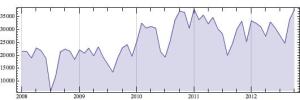
Maritime shipbuilders in front of ship. Photo Credit: CBC.
It’s a chapter of history mostly forgotten, not just across Canada but even in the Maritime provinces themselves. Shipbuilding – like fishing – is an obvious fact of life on the Atlantic coast, but few people today know just how extensive the industry once was. There was a time not that long ago when men built ships in sheltered harbours, on open beaches and up narrow rivers – ships that went on to carry cargoes and passengers all over the world.
From the first boats built by the earliest settlers, to the golden Age of Sail in the 1800s, and from the Grand Bank fishing schooners to the high tech naval frigates of today – the thousands of vessels built in Atlantic Canada during the past 250 years have shaped the region like no other industry.
Maritime Shipbuilding is a half hour documentary that explores this seafaring history and the proud tradition that lives on to this day. The film travels to once-thriving shipbuilding centres in the Maritimes to rediscover the story of one of the world’s most vibrant, productive, and profitable shipbuilding regions.
Although no longer the economic driving force it once was, the shipbuilding industry in Atlantic Canada continues to prosper. The thousands of people who recently attended the re-launch of the Bluenose II in Lunenburg, Nova Scotia are a testament to that enduring legacy.
Maritime Shipbuilding was written and directed by award-winning Halifax documentary-maker Geoff D’Eon, (Blood On The Coal/Facebook Follies) and produced by Edward Peill from Halifax-based Tell Tale Productions Inc.
“This was an interesting piece to work on. More than 28,000 ships built in the Maritimes? Who knew?” says D’Eon “It’s not only the numbers that are surprising, but the locations where these ships were built, places that today show no trace of the industry that once was.”
Maritime Shipbuilding will have its world broadcast premiere on CBC Television’s Land & Sea on Sunday, December 9, 2012 at 12 Noon. Following the broadcast, the documentary can be watched on the CBC TV website at: www.cbc.ca/landandsea. Land & Sea is CBC’s 2nd longest running TV series and can be followed on Twitter: @cbclandandsea
Maritime Shipbuilding was produced in association with CBC TV with funding from Film NS, and Provincial and Federal tax credits.





